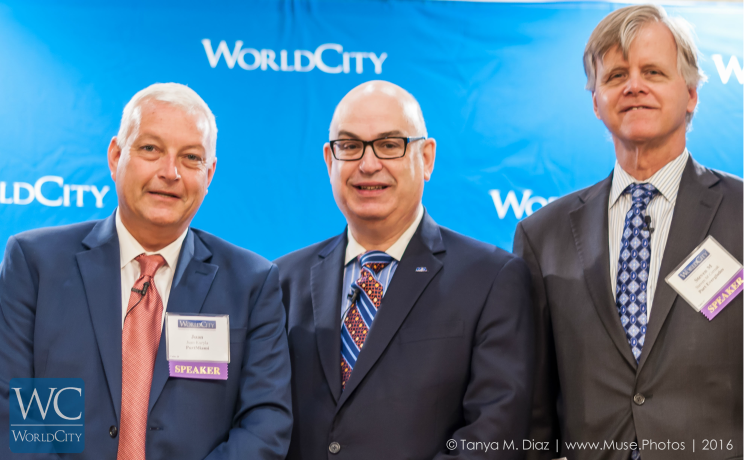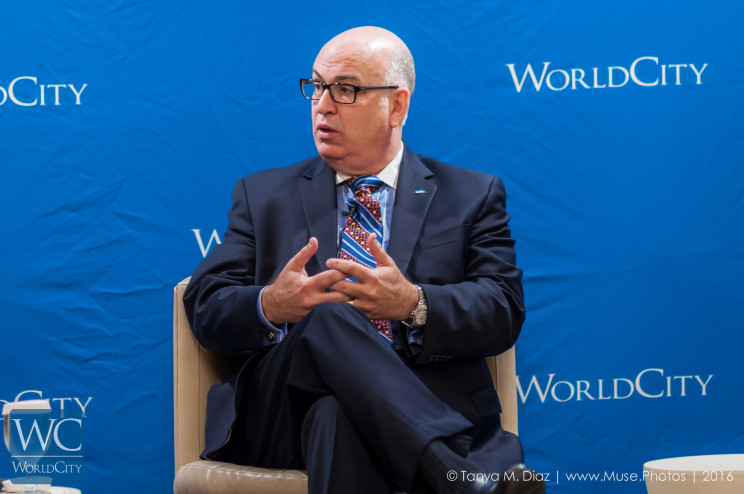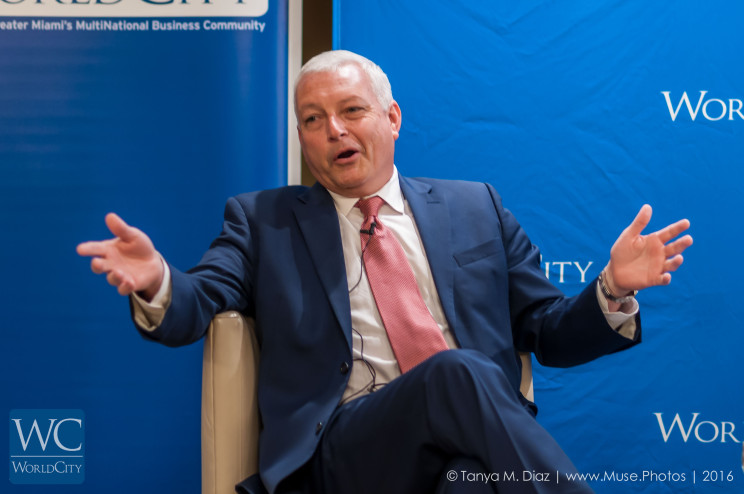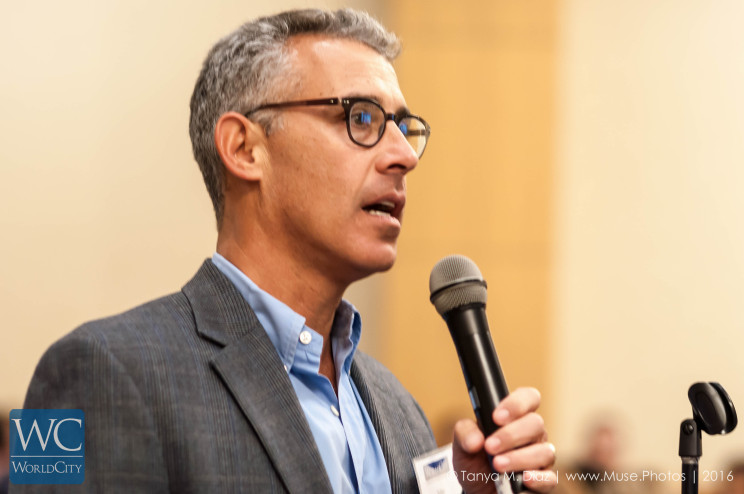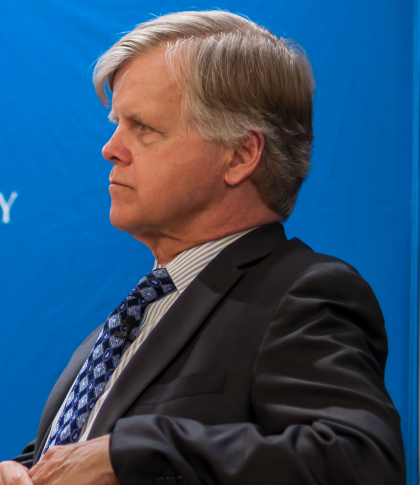South Florida trade heading for 4th year of decline in value
South Florida’s trade with the world is on track for its fourth straight year of declines in 2016, largely because of problems in key trade partners Brazil and Venezuela and lower prices for oil and metals.
Still, there are some bright spots: trade is rising with Dominican Republic, Argentina and Ireland. Plus, the opening of the Panama Canal expansion should bring mega-ships with heftier loads to the area.

May is World Trade Month, kicked off on April 29, 2016 with local port directors from MIA, PortMiami and Port Everglades
Those were among highlights of WorldCity’s Trade Connections event held April 29, 2016, and headlining directors of the area’s top three ports: Miami International Airport, PortMiami and Port Everglades. The luncheon also featured the release of WorldCity’s latest annual TradeNumbers publication for the Miami Customs district.
South Florida trade down 8 percent in 2015
WorldCity President Ken Roberts kicked off the gathering with data from TradeNumbers:
- South Florida’s trade fell for an unprecedented third straight year in 2015, down 8.07 percent to $106.85 billion. Exports dropped 10.62 percent to just shy of $58.60 billion, and imports slipped 4.77 percent to dip below $50 billion for the first time since 2011.
- That’s in line with shrinking U.S. trade overall. As the price of oil imports plunged, Canada lost its perch as the nation’s top partner to be replaced by China for the first time. Also, oil lost its spot as the country’s top import for more than a decade to be surpassed by motor vehicles.
- The fall in the price of fuel imports meant that South Florida lost its long-time position as the Customs district with the country’s largest trade surplus to be replaced by Houston in 2015.
“It’s not because of anything Miami is doing wrong” that trade is down, Roberts told an audience of more than 150 people in Doral. Trade continues to dip this year because of recession in parts of South America, weak commodity prices and the shutdown of an Intel computer-chip plant in Costa Rica that used to export through Miami. Intel moved production from that plant to Asia, said Roberts.
MIA improving cargo facilities
To boost trade, South Florida’s largest airport aims to expand facilities for cargo, especially for temperature-sensitive medicines. The airport recently become the first in the Americas certified for handling those pharmaceuticals, said Emilio Gonzalez, who runs MIA and the Miami-Dade County Aviation Department.
“Every passenger airline that comes to MIA is just as interested in cargo,” said Gonzalez, noting that the Miami airport long has ranked as No. 1 in the United States for international cargo. “We hope never to be in a position to tell people, “There’s no room at the inn.”
Fort Lauderdale’s seaport also is adding facilities. It expects approval from U.S. Congress soon to deepen and widen its channel to handle larger ships that will cross the expanded Panama Canal. In addition, it’s soon to request proposals for larger cranes to unload larger ships, said Port Everglades Director Steve Cernak.
Miami’s downtown seaport reported strong growth in the 12 months ended Sept. 30, 2015, said PortMiami Director Juan Kuryla. It saw a 15 percent gain in containerized cargo for the budget year to top 1 million TEUs or 20-foot trailer equivalent units, the industry’s measuring stick. That was the seaport’s best cargo performance in a decade and reached volumes similar to Port Everglades’ level.
Containerized cargo up at PortMiami
What’s more, PortMiami has seen 9 percent growth in containerized cargo this budget year and could reach double-digit gains for the year ending Sept. 30, Kuryla said. That’s partly because of larger vessels coming to Miami after a deepening of the port channel to 50-feet, he said.
Yet challenges to trade remain beyond the current crises in Brazil and Venezuela, weak global economy and rapid consolidation in the shipping industry, audience members said.
Questions now swirl over new international rules on weighing ship cargo hat are set to take effect July 1, said John D. Abisch, regional CEO for less-than-container-load cargo specialist ECU Worldwide.
PortMiami “is talking with operators to have that in place,” said Kuryla. And Port Everglades “is trying to ensure as smooth a transition as possible” to those new rules, Cernak said.
More TSA officers coming to MIA
To speed international travel and trade amid stricter security measures, MIA also has been working to obtain more resources from U.S. authorities. Starting this summer, the airport expects to host dozens more officers from the Transportation Security Administration, said Gonzalez, emphasizing: “We still have to depend on our federal partners to do our job.”
Fuel handling remains a concern too, as more ships switch from diesel to liquefied natural gas often called LNG.
“By 2020-2021, PortMiami will have to be an LNG-ready port. For us, it will be a competitive issue,” said Kuryla. Port Everglades also is
looking into questions of LNG storage, said Cernak.
South Florida’s three ports have different profiles for trade, Roberts told attendees.
Top partner differs for each South Florida port
In 2015, MIA handled the most by value: $37.73 billion. Brazil ranked as its top trade partner, partly because of trade between the airport and Brazil in civilian aircraft, engines and parts.
Port Everglades was second in value at $13.24 billion, but Dominican Republic ranked as its top partner. The Fort Lauderdale seaport handled mostly north-south trade including cellphones, computers and other high-tech goods shipped south and apparel, fruit and other foods shipped north, TradeNumbers shows.
PortMiami trailed at $10.30 billion in trade in 2015, with China as its top partner. It handles more east-west trade, including ships that cross the Panama Canal from Asia carrying freight bound for the U.S. East Coast and the Caribbean, said Roberts.
“We’re very blessed for where we are located,” said MIA’s Gonzalez, summing up South Florida’s natural advantages for international trade. “but we still have to work for it. It’s a very competitive business.”
Trade Connections is one of four event series organized by media company WorldCIty to bring together multinational executives in greater Miami. The Trade series is sponsored by HSBC banking group, American Airlines Cargo, PortMiami and Miami-Dade County Aviation Department.
The next Trade Connections event is set for June 17 on the topic, “Argentina: the New Rising Star.”
